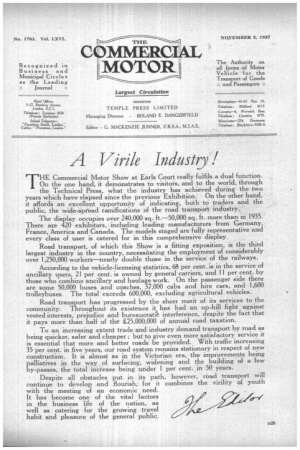A Virile Industry!
Page 1

If you've noticed an error in this article please click here to report it so we can fix it.
THE Commercial Motor Show at Earls Court really fulfils a dual function. On the one hand, it demonstrates to visitors, and to the world, through the Technical Press, what the industry has achieved during the two years which have elapsed since the previous Exhibition. On the other hand, it affords an excellent opportunity of indicating, both to traders and the public, the wide-spread ramifications of the road transport industry.
The display occupies over 240,000 sq. ft.-50,000 sq. ft. more than in 1935: There are 420 exhibitors, including leading manufacturers from Germany, . France, America and Canada. The models staged are fully representative and every class of user is catered for in this comprehensive display.
Road transport, of which this Show is a fitting exposition, is the third largest industry in the country, necessitating the employment of considerably over 1,250,000 workers—nearly double those in the service of the railways.
According to the vehicle-licensing statistics, 68 per cent, is in the service of ancillary users, 21 per cent. is owned by general carriers, and 11 per cent. by those who 'combine ancillary and haulage work. On the passenger side there are some 50,000 buses and coaches, 37,000 cabs and hire cars, and 1,600 trolleybuses. The total exceeds 600,000, excluding agricultural vehicles.
Road transport has progressed by the sheer merit of its services to the community. Throughout its existence it has had an up-hill fight against vested interests, prejudice and bureaucra4 interference, despite the fact that it pays more than half of the £7,5,000,000 of annual road taxation.
To an increasing extent trade and industry demand transport by road as being quicker, safer and cheaper ; but to give even more satisfactory service it is essential that more and better roads be provided. With traffic increasing i
35 per cent. in five years, our road system remains stationary n respect of new construction. It is almost as in the Victorian era, the improvements being palliatives in the way of surfacing, widening and the building of a few by-passes, the total increase being under 1 per cent. in 50 years.
Despite all obstacles put in its path, however, road transport will continue to develop and flourish; for it combines the virility of youth with the meeting of an economic need.
It has become one of the vital factors .4*-1 in the business life of the nation, as well as catering for the growing travel habit and pleasure of the general public.


















































































